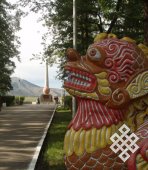
 In Kyzyl, the capital of Tuva, on the picturesque shore near the confluence of the Bii-Khem and Kaa-Khem rivers, which give the origin to the Great River Ulug-Khem, there stands a majestic obelisk: Center of Asia”. There is deep significance in the name of the obelisk: Tuva is at the maximum distance from the world’s oceans; it means that it is at the geographic center of the Asian continent.
In Kyzyl, the capital of Tuva, on the picturesque shore near the confluence of the Bii-Khem and Kaa-Khem rivers, which give the origin to the Great River Ulug-Khem, there stands a majestic obelisk: Center of Asia”. There is deep significance in the name of the obelisk: Tuva is at the maximum distance from the world’s oceans; it means that it is at the geographic center of the Asian continent.
Since times immemorial, this area has been the crossroads and meeting place of cultural traditions of the East and West, of the North and South; this is where mutual influence and mutual enrichment of different cultures took place.
The Tuvan land holds treasures, created by artistic imagination and talented hands of its ancient dwellers – the precursors and ancestors of today’s Tuvans. Very few places can be found in the world, where such masterful examples of metal artwork can be discovered as in the Uyuk valley (kurgans Arzhaan I and II), or galleries of petroglyphs unique in subject and in the high quality of artistic execution as in the Sayan canyon of the Yenisei (Mugur-Sargol and others). These examples can be multiplied. The testimonies to high culture in the past of Tuva are innumerable, they are all over the place, and the list of the treasures keeps growing. It will be no exaggeration to call Tuva, together with neighboring Altai, the pearl of Central Asian archeology.
Over many centuries, this country, located at the crossroads of ancient dry land and water roadways, has attracted the attention of travelers and neighbors-contemporaries; many testimonies about it have been preserved in historical chronicles, accounts and epics. The historian’s task is to provide an objective evaluation of these works, to separate the descriptions of genuine historical facts and events from later embellishments and inventions.
Out of the many works dedicated to Tuva, some, which were published in small editions, for example, in provincial periodicals of small circulation, have become a bibliographic rarity; a lot of foreign publications also have become rare books, now difficult to find even for specialists. Some have been totally forgotten, others only partially, even though most of them have kept their scholarly significance to this day.
The editors of the anthology took upon themselves the role of elucidators, a noble and praiseworthy work. They strove to include, to make accessible, to bring to everyone, and especially to the representatives of the young generation, priceless sources and explorations in the history of their native land. Anthology is a Greek word that literally means “bouquet of flowers”. At first, collections of ancient Greek lyrical poetry used to be call anthologies, and later the name was also applied to collections of most representative works of various authors. In this case, a bouquet of historical testimonies and explorations about Tuva is presented to the reader. This publication represents the very first attempt at creating such an anthology.
The initiator of this publication is a social activist known to all, a genuine hero of our times, Sergei Kuzhugetovich Shoigu. Even in long-ago times, as a schoolboy with an inquisitive mind, he participated in the work of the archeological expedition led by famous archeologist and talented organizer, Alexander Danilovich Grach in the flood zone of the projected Sayan dam. This led to the deepening of his interest in the past of his nation, interest which was started by his father – a savant of Tuvan history Kuzhuget Sergeyevich Shoigu.
The wide scope, the selection of works of prominent scholars – Russian and foreign, as well as those of less well known eyewitnesses of events in the past of Uriangkhai-Tuva is impressive. The anthology is also interesting in that it includes excerpts of works of art.
Both the student with an inquisitive mind and the narrow specialist will find texts to their interest and taste, collected by the editors “in one binding”. A deeper acquaintance with this anthology, which will now, thanks to S.K.Shoigu, be accessible to very many people, will, without a doubt, lead to development of love to the native country and its history in an inquisitive and searching mind. It will also help to recruit the young generation to active participation in archeological research in Tuva, and to protection of monuments of ancient history and culture.

